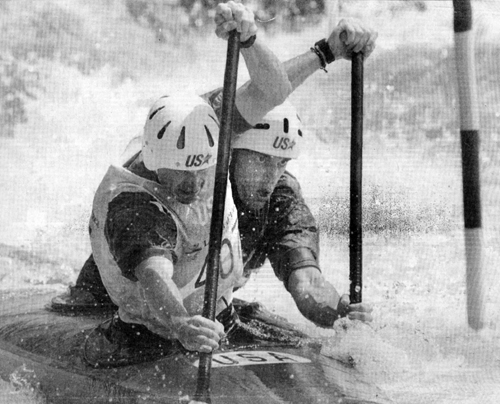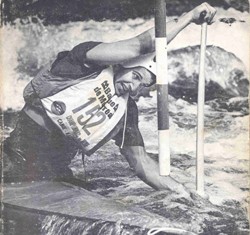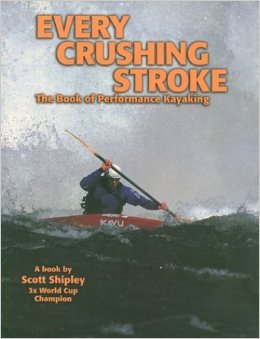Every Crushing Stroke - The Olympic Revolution, Part V

|
"Every Crushing Stroke" is a classic (book) about performance kayaking written by three-time World Cup Champion Scott Shipley and published in January 2002. "The Olympic Revolution" is the first chapter of the book and gives an interesting image of canoe slalom in the eighties and nineties. In the coming weeks Sportscene will re-publish extracts. The book has become a collectors item but can still be bought on Amazon. Below extract number 5. Previously published extracts:
|
The Junior Circuit II
Scott Shipley, 2002 - These are often very complicated gate moves and paddlers will isolate this move until they have mastered it. We did more than that; we isolated every part of our training. We would just sprint down through a rapid to focus on our paddling in whitewater, or we would pick a large, river-wide wave and practice the fastest way to cross that wave-without any gates! We did stroke drills, short courses with our eyes closed and a hundred different exercises designed to isolate a hundred different skills. Everything that was a part of our racing was isolated, broken down, and then put back together in its perfect form.
I look back now at how little we knew and wonder that we ever came as far as we did. We became the masters of bumbling our way to success. I can remember a particular workout where we were working on phase changes-the ability to change our pace in a race run. The idea goes something like this: If you are sprinting as fast as you can downstream against a competitor and you go five miles an hour while your competitor goes four miles an hour you will be only twenty percent faster than your competition. To put this in a real context lets say you sprint out of the starting gate and arrive at the first gate eight seconds later. When you get there you will have gained two seconds -at a grave expense of energy- on your competitors.

Now let’s say further down the river you are doing an upstream in the current so that you must paddle against a three mile per hour current. Again you sprint at five miles an hour and your competitor at four. Now you are going twice the speed of your competitor! In the two seconds it takes you to do this gate you gain the same two seconds on your competition. We were looking for those two easy seconds.
We came up with this theory at one point and decided to practice doing all our upstreams at a sprint. For our training we put together a forty-five second course with three or four upstreams and did runs where we emphasized the slow and the fast. As we paddled between the upstreams we cruised and let the boat glide. Then as we approached the upstreams we'd pour on the gas and sprint into and out of the gate with hopes of gaining a second on our competitors. Was the workout a success? Not even close, not a single one of us could consistently do a good turn after sprinting into the upstream. Our pacing was off, our accuracy was horrendous and all of us constantly hit the poles. However we knew the theory was good and we hammered away at the details for weeks. What eventually came of the workouts is now standard technique that any beginning junior could tell you: Approach your upstreams with control, precision, and preparation-exit them with crushingly powerful strokes. Come in precisely and leave powerfully.
To truly understand the kind of of training we were doing in those days I think it is important to put some of my training as a junior in context. I trained on gateless flatwater five days out of seven. I traveled four hours to Canada every weekend to train with the Canadian team there. I was coached for maybe two weeks during the summer and a weekend or two a month throughout the winter. My training partners were an incredibly keen group of C-l s and women kayakers and the nearest competitive K-l junior lived 3000 miles from my house. Most athletes today would look at this situation as primitive and substandard. By today's standards I had no training site, no coaching and no competitors. However, the situation had the advantage of forcing me to find alternative methods of training-many of which shaped the way I paddled for the rest of my career.
 They say necessity is the father of invention and this could not have been truer than it was for my training those days. I had a flatwater lake but was competing every weekend against the C-ls and K-1s that were training full-time on whitewater gates. I took Eric's lessons to heart and found workouts on flatwater that isolated every part of a slalom run on whitewater. I did sprints that went sideways to work on my rotation and sprints with five starts and five stops to work on my acceleration. I invented these and million other drills to make up for the time I was missing in gates.
They say necessity is the father of invention and this could not have been truer than it was for my training those days. I had a flatwater lake but was competing every weekend against the C-ls and K-1s that were training full-time on whitewater gates. I took Eric's lessons to heart and found workouts on flatwater that isolated every part of a slalom run on whitewater. I did sprints that went sideways to work on my rotation and sprints with five starts and five stops to work on my acceleration. I invented these and million other drills to make up for the time I was missing in gates.
I became the master of self-evaluation. Each weekend was a test that I invariably failed for some reason or another. If I felt I was slower because of offsets one weekend I'd hang my single gate and work on offsets every day that week until I had become perfect at offsets. The next week I might have trouble with my full-spins and do the same. It was a fantastic system of training because it became a weekly cycle of evaluation and improvement.
Where my competitors were training rhythmically for the year only to test themselves at the next big event I was, on a weekly basis, re-evaluating my performance and finding ways to improve it. I inch-wormed my way to the top by constantly raising the level of my weakest points. Ladies World Champion Lynn Simpson told me once that she used to work the same way, focusing on her weak elements until they became her strong elements. This is a parallel in our training that I found fascinating. I've since concluded that it is this ability to recognize your weaknesses that makes great champions. A little self-criticism can go a long way in this sport.
Editor: Jan Homolka





